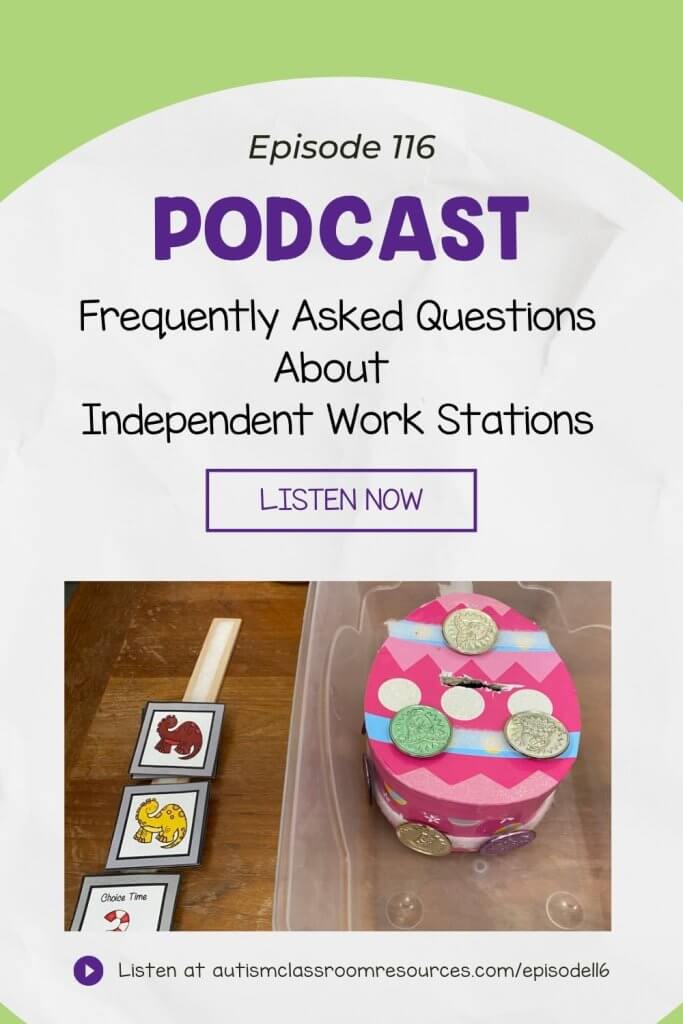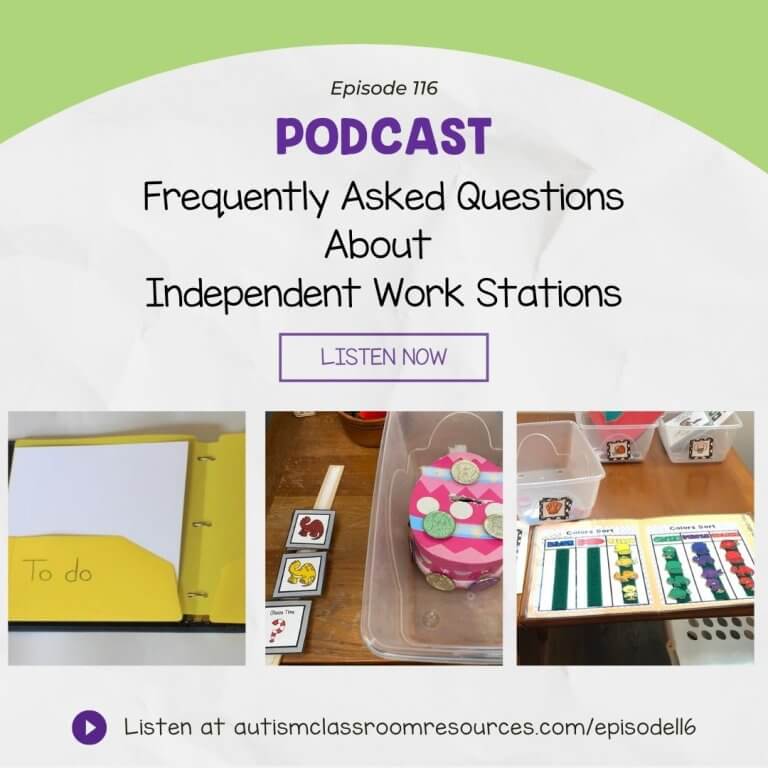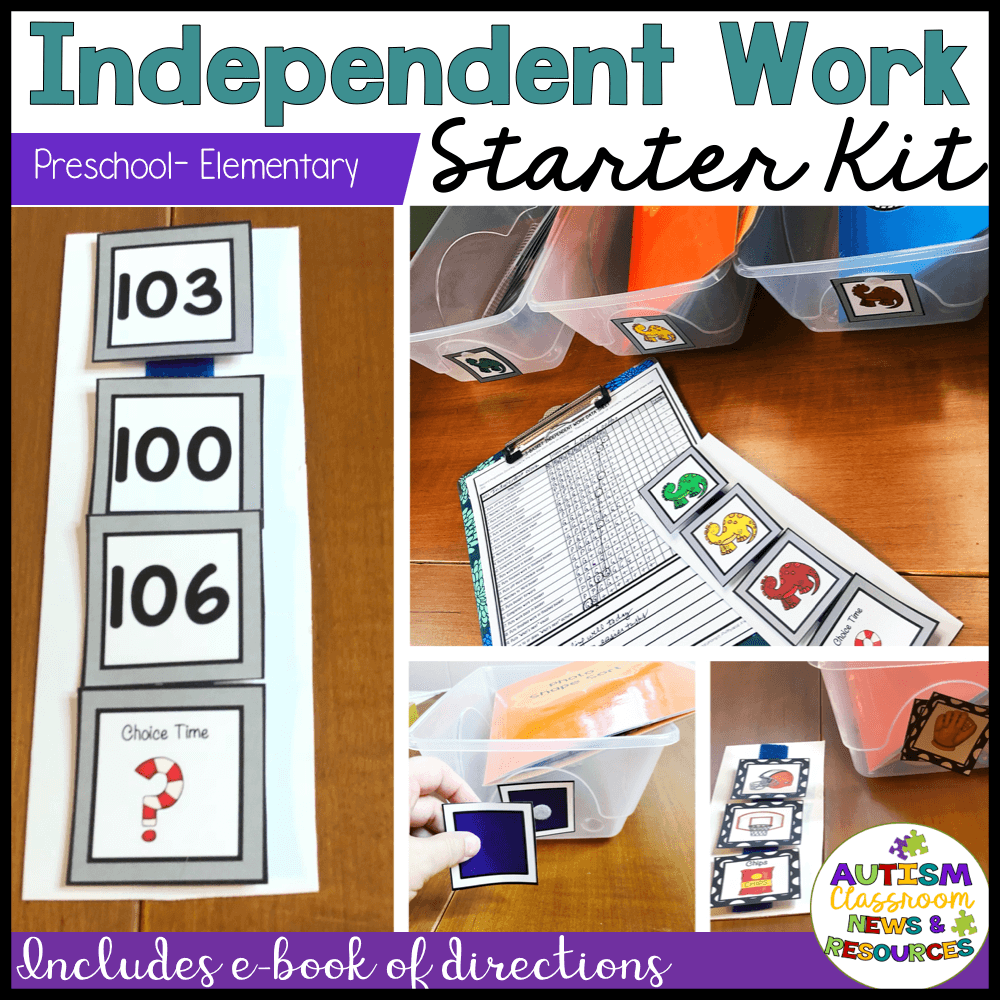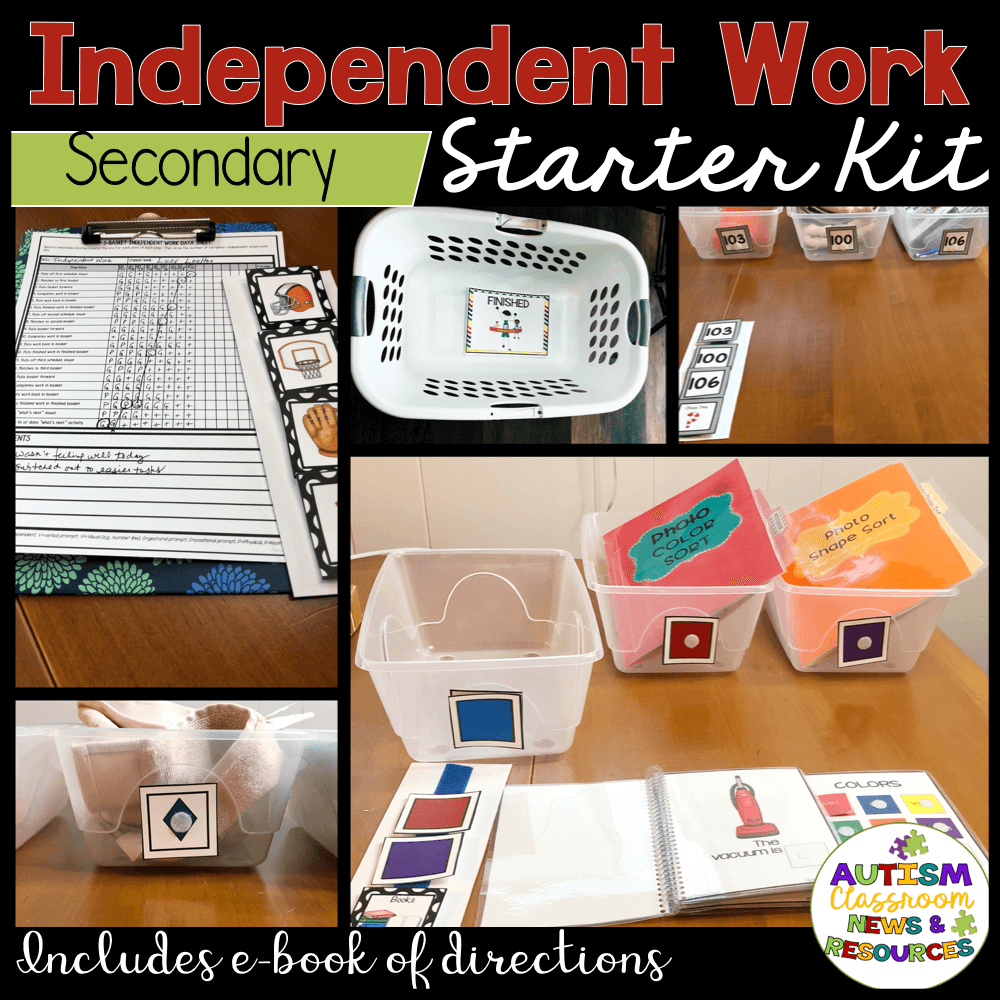Welcome to the Autism Classroom Resources Podcast, the podcast for special educators who are looking for personal and professional development.
Christine Reeve: I’m your host, Dr. Christine Reeve. For more than 20 years, I’ve worn lots of hats in special education but my real love is helping special educators like you. This podcast will give you tips and ways to implement research-based practices in a practical way in your classroom to make your job easier and more effective.
Hello and welcome back to the Autism Classroom Resources Podcast. I am so happy to have you back here. I’m Christine Reeve and I am the host, and the owner of Autism Classroom Resources. I am super excited to be finishing up our series on independent work systems this month. Today, I’m going to be answering some frequently asked questions that I get about them. We have talked about why we would use them in the classroom, we’ve talked about some critical elements, some frequently made mistakes and today, I want to talk about some of the most frequent questions that I get about independent work systems and some of the things that people struggle with or ask as they’re setting up in their classroom.
But just before I start, I’ve got a free webinar that can get you started the right way with independent work in your classroom, plus it’s got a bonus, if you watch it to the end, the bonus includes materials that will help you get set up and help you monitor your students’ independence, and it’s also got a link to the book that I wrote with Dr. Kabot, all about independent work systems there as well. You’ll find that link in the show notes but you can also find it at autismclassroomresources.com/episode116. Now, let’s get started.
The first question that I get a lot is, “What do I do if he never finishes his work?” Often, it’s because the student isn’t finishing his work or because the teacher has never seen him finish work and figures that he’s not going to. For some, it’s surprising when you give him the system and teach him to use it, that he actually does finish it. Of course, it’s an important question when you have independent work scheduled into your day because it impacts how long you should have it scheduled.
Of this frequently asked question, I actually have three questions that I usually start out with to ask when someone asks me this question because if you’ve known me for any length of time, there’s always more questions before I have an answer. The first one is, “Do you have the right tasks? Are the tasks that he’s actually mastered, so are they, in other words, things that he can do independently? Do they have a clear beginning and a clear end? Does he know when they’re finished?” I talked about both of these in the last episode, in Episode 115. I talked about why they’re important. But if they aren’t mastered tasks or/and they don’t have a clear beginning or end, then you don’t have the right tasks. At that point, you need to re-look at your tasks.
The second question is whether or not he knows what to do when he’s finished. Oftentimes, students don’t finish because they aren’t sure what comes next. This is one of the four questions that I talked about in Episode 113. If you don’t have a schedule or you have a schedule but it doesn’t have that, “What’s next? What do I do when I’m done with my system, when the system is finished?” you need to add that in. Chances are good that he might finish his work once you add that in.
Your third question is, “Is your what’s next reinforcing for him? He needs a reinforcer when he’s done to motivate him to get through the task, just like we all do, because remember the kid that I talked about in Episode 115 who was standing on his head on a chair, then I put the computer visual down as the what’s next and he finished his work in five minutes flat? Sometimes, it’s all in the motivation to get the work done. He even knew, “The faster I get it done, the more time I get.” That’s one of the advantages of using independent work in a center situation, that I get my work done quickly, I get more time with my reinforcer. If I take my time with my work, I get less time with my reinforcer. There is some differential reinforcement there too.
Now, if those three answers have all been dealt with and they still aren’t finishing their work, then you need to decide if he needs less of the work to complete. Is he able to complete the amount of work? In other words, is he working the whole time but he’s not finishing, in which case, do you need to bump up the time that’s allotted for him to finish? But if he’s goofing off and not finishing still, then you probably want to let him not finish and not get the reinforcer, the what’s next, a few times as a natural contingency, and see what happens. You want to let him come into contact with the fact that well, you didn’t get it, that’s what happens. I have a post with more specific guidelines and questions to ask with it on the blog. You can find that at autismclassroomresources.com/finishes-independent-work or you can just grab it in the show notes.
The second question that I get frequently is, “How do I get my staff to stop talking when prompting students?” This is something I haven’t talked a lot about, but when we teach independent work systems, we use only non-verbal prompts. We don’t talk to the students. The reason is we don’t want to be anything other than a part of the system. We don’t want them looking to us for directions. We want them looking to the system for directions, so we can fade ourselves out. I hear this question so much because in truth, most of us don’t know how much we are talking. I include myself in that, especially because if you’ve listened to the podcast, I know that I talk a lot. We just don’t realize the importance of redirecting and prompting silently. We don’t always realize that we’re actually saying words all the time. We are used to talking to students. We’re used to telling them what to do. It’s an automatic reaction. But when we do independent work, we’re trying our very best not to do that so that they focus on the system, so we use nonverbal cues, we don’t talk, and we just fade away. We don’t want to be who they look for.
One way to get everybody on board with nonverbal prompts is to use visual reminders for the staff. I have visual poster reminders that we are quiet during independent work—and by we, I mean the staff—that I use that are part of my visual support for staff set on Teachers Pay Teachers. I’ll put a link to them in the blog post. But a simple quiet reminder will often just suffice for the staff as well.
Another thing I often do is I will make a deal with the staff that we will try to remind each other to keep quiet. I’ll ask them to remind me, if they hear me talking when I shouldn’t be, and we’ll invent a signal that the kids won’t know, “I hear you talking. You need to be quiet.” I’ll give them a signal if I hear them talking. That way, it’s clear that I’m not targeting them. This is a collaboration. It’s hard for all of us to catch our own behavior at times, so better to make it a back and forth effort rather than you doing it to them.
The third question I get is, “Does every student have to have his own work system?” When TEACCH first started, they really did it this way. I think they do it more flexibly now with some centers and some individuals. Typically, when I do it, my short answer really is no, not everybody has to have their own system. I typically set them up as centers. Every student does not have to have his own individual set of tasks, baskets, folders, systems. I typically set up independent work systems as centers that all the students rotate through in a self-contained class. Now, if I have a student who’s doing independent work while the general ed class is doing morning work, he might have his own notebook or he might have his own basket system, depending on what his needs are. I may have very individualized systems within the independent work area too. Different students may have different needs.
As the students rotate in a self-contained classroom through their instruction time centers with the teachers and practice time with the paras, they also have an independent work time center. That allows us to break those centers down into smaller groups, especially once they start to get some independence at independent work, so we can staff that less intensely. In these cases, multiple students will have one system but it might have different tasks in it, depending on what their skills are, or if they’re working on the same level, then they might have the same tasks. Usually, I’ll label the task sets with the student’s name so that the staff that’s running the centers know where the students work and which one to set up for who’s coming to that station next.
This is particularly important if you’ve individualized any systems for any of your students. For instance, if you have a student or a student who’s using a notebook system or going to get their own basket tasks from a shelf and others that are only working on tasks right in front of them, you’re going to need to let that person know easily who’s going where so they know which thing to set up. I use centers because I almost never have a classroom that has room for every student to have their own basket system in front of them. I also like to separate their teacher instruction with prompting and direction from the teacher, from their independent work, where the teacher is not giving direction and they shouldn’t be looking for prompts from the staff. I like to give that differentiation of how the staff responds and make it clear that those two things take place in different places.
Sometimes, that’s important, sometimes, it’s not. It depends on your students. It’s difficult because at times, if I have individual systems, it’s harder to share tasks unless you’re able to keep them in a central place. It’s harder because they’re all over the place, so I can’t share this matching task with three kids without moving it around the room. Now, for older students, I’ve also had whole vocational rooms that are set up with independent work systems. There’s lots of ways you can set them up as long as they’re answering those four basic questions from Episode 113.
Number four, “What if the student isn’t independent yet?” That is a really good question because on the one hand, why would we be using an independent work system if a student was already independent? We can only teach independence with a work system. We can’t teach other skills with it because the work has to already be mastered. The purpose is to teach the student to do a series of tasks independently. “But what if they don’t have any skills independently yet to practice in the system and they don’t know how to use the system so they don’t have the ability yet to do any of it independently?” That’s where most of our students start with independent work.
For those students, we start where they are. If they have no independent tasks, start with a simple, what we call a Put-in Tasks. Put-in Tasks are simple tasks that just require the students to pick up an item and put them in a container. I have a lot of them on the blog. I will link to them in the blog post with examples but you can also just go to autismclassroomresources.com, go to the search bar at the top—I don’t think there’s a search bar on mobile. I keep meaning to fix that—but do a search for Put-in Tasks and you will find a ton of blog posts of examples. I have some videos of them and how you can make them on YouTube, and on the blog as well. Usually, I start with just two or three little items that they’re going to put in the container, three coins, three blocks and they’re going to be doing it with hand over hand prompting it first because they don’t know how to do it.
They start with that basket right in front of them and one scheduled visual, and a visual of a highly reinforcing activity. It might even be a container with an edible item that they like, that they can see but not open. They may do that one task system with different Put-in Tasks, same skill, different materials, multiple times during their independent work time. They’re doing that quick task, they get their next item for a few minutes, then they do another system, then they enjoy their next, then they do another system. Each time, they’re putting it in the finished basket, getting their what’s next, then they do their finished, then they do it again and you do it over, and over. That’s where we start.
As they become more independent, we can start to add elements to the basket, to the system, add a basket with another piece of the schedule, so we’re making more tasks that they have to do but that’s the most basic place to start. It’s very, very simple but it’s all doable. The students can learn to do it and become independent with it. We can build it up to more complex skills. Just make sure you have the elements in place and that you’re fading the prompts before you move to the next step. Make sure you get to independence before you move to the next step.
Those are the four of the most frequently asked questions that I get about independent work systems. There are tons more, so I’m sure I’ll be back in the future with more. If you have questions that you would like answered, feel free to DM me on social media with them and I’ll be happy to answer them if I can. If you’re interested in learning more about independent work systems, definitely grab the free webinar at autismclassroomresources.com/episode116 and grab the bonuses at the end of that video as well. I’ll make sure that that link is in the show notes as well. Thanks so much for listening. If you have liked this little series on independent work, don’t forget to leave a review on iTunes. I hope that you’ll come back next week when we will be starting with our next monthly topic. Until then, have an amazing week.









